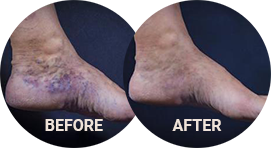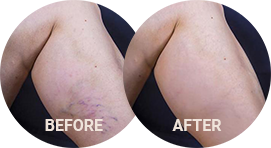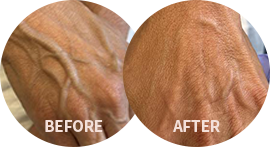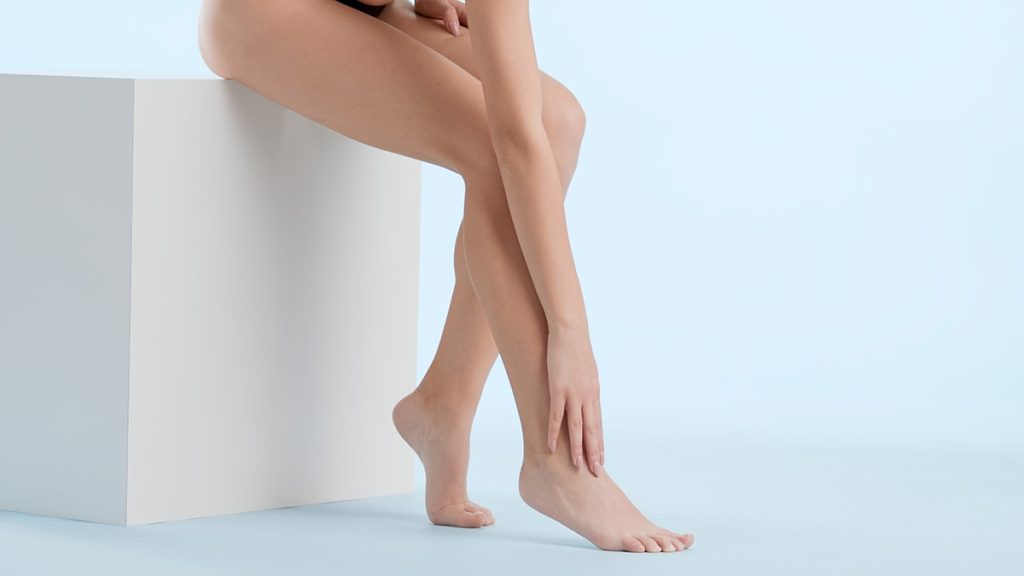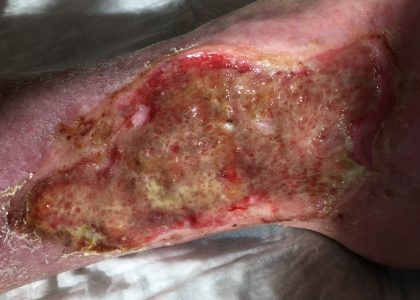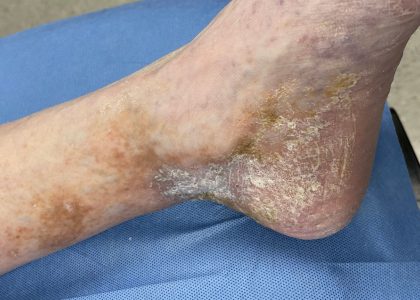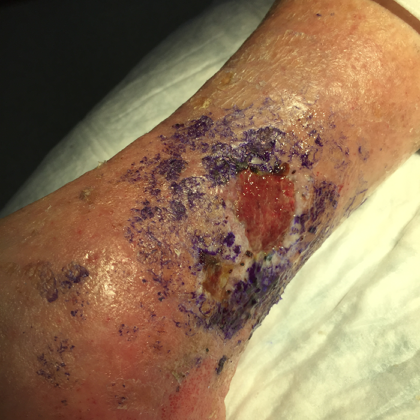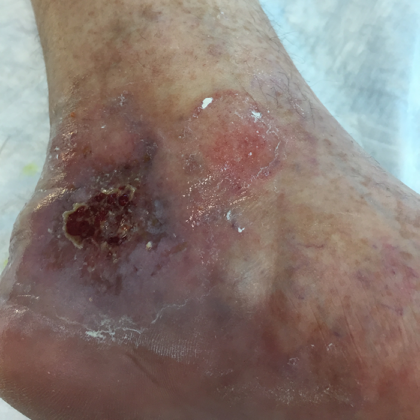A venous ulcer is an open, painful sore that can take weeks, months or even years to heal, significantly impacting a person’s quality of life. Venous ulcers typically occur in the lower legs, ankles and feet, and they are caused by a variety of underlying conditions.
If you are experiencing leg ulcers that just won’t heal, it’s possible that you are suffering from venous ulcers. But why do they occur? These types of ulcers are common and can occur as a result of compromised vein function. Over time, this can damage the skin and tissues of the legs, resulting in painful and persistent venous ulcers.
At Premier Vein Clinic, board-certified vascular surgeon Dr. David Naar understands the complicated nature of venous ulcers and utilizes a personalized approach to treat each patient’s unique condition. Don’t let venous ulcers continue to impact your quality of life – schedule an appointment with Dr. Naar at our Westlake, Ohio location by calling (440) 641-0433 or by completing a form on our website.
Contents
Before and After Photos
About Venous Ulcers
Venous ulcers can be a painful and frustrating condition to deal with. As an experienced vascular specialist, Dr. Naar understands the causes of venous ulcers and can help you find relief.
What are the symptoms of venous ulcers?
Symptoms of venous ulcers include open sores on your legs or ankles that may be painful or itchy. You may also experience heaviness, aching, swelling, throbbing, redness, and discoloration around the affected area. If you notice any of these symptoms, it’s important to seek medical attention from a vein specialist.
Here are some insights into the leading causes of venous ulcers.
Venous Reflux
One of the primary causes of venous ulcers is venous reflux, a condition in which the valves in the veins of the legs become damaged or weakened. This can lead to blood pooling in the veins, causing swelling, inflammation, and ultimately, ulceration.
Chronic Venous Insufficiency
Chronic venous insufficiency (CVI) is another common cause of venous ulcers which is a condition strongly associated with venous reflux. CVI occurs when the veins in the legs are unable to efficiently transport blood back to the heart. Over time, this can cause the veins to become enlarged and distorted, leading to venous ulcers. In total, roughly 5% of CVI cases result in leg ulceration. (1)
Other Conditions
In addition to venous reflux and CVI, several other underlying conditions can contribute to the development of venous ulcers. People with diabetes, for example, are at a higher risk of developing venous ulcers due to poor circulation and nerve damage in the feet and legs. Other risk factors for venous ulcers include:
- Deep vein thrombosis (DVT): DVT occurs when a blood clot forms in a vein deep within the body. If left untreated, DVT can lead to venous ulcers.
- Obesity: Being overweight or obese puts extra pressure on your veins, increasing your risk for venous ulcers.
- Age: As we age, our skin becomes thinner and less elastic, making it more prone to injury and slower to heal.
Don’t Wait To Treat Venous Ulcers
If you are experiencing the symptoms of a venous ulcer, such as pain, swelling, or an open sore on your leg or foot, don’t wait to seek treatment. Seek medical attention as soon as possible when: (2)
- The ulcer has persisted for longer than three months
- The initial ulcer length of 10 cm (3.94 in) or more
- You suffer from lower limb arterial disease
- You are of advanced age
- You have an elevated body mass index (BMI)
It is important to note that over 40% of venous ulcers are classified as chronic. (3) Therefore, the earlier they are managed, the better the prognosis. At Premier Vein Clinic, we specialize in the diagnosis and treatment of venous ulcers. Dr. Naar utilizes the latest diagnostic and treatment techniques to help patients achieve optimal outcomes. Depending on the underlying cause of your venous ulcer, we may recommend treatments such as compression therapy, wound care, or minimally-invasive procedures to address venous reflux or CVI.
Candidates
Patients who may seek treatment for venous ulcers include those who:
- Have a history of deep vein thrombosis (DVT)
- Are overweight or obese
- Lead a sedentary lifestyle
- Have a family history of CVI
- Are elderly
- Have had a previous leg injury or surgery
- Have varicose veins or spider veins
If you suspect that you may have CVI or are experiencing symptoms such as leg pain, swelling, or discoloration, it is important to seek medical attention from a qualified vein specialist like Dr. Naar. At Premier Vein Clinic, we offer a range of diagnostic and treatment options to help manage CVI and prevent the onset of venous ulcers. Contact us today to schedule a consultation and learn more about how we can help you achieve healthy, beautiful legs.
Personal Consultation
During your consultation, Dr. Naar will discuss your symptoms with you and review any prior treatments you may have received for your condition. He will then recommend a personalized treatment plan based on your individual needs. Treatment options for venous ulcers may include compression therapy, wound care, and, in some cases, minimally invasive surgical intervention.
Our goal at Premier Vein Clinic is to provide our patients with the highest quality care possible. We understand that venous ulcers can be painful and debilitating, and we are here to help you find relief. Contact us today to schedule a consultation with Dr. Naar and take the first step towards healing your venous ulcers. Call (440) 641-0433 or fill out an online inquiry form for more details.
Managing Venous Ulcers
At Premier Vein Clinic, we offer various treatment options for venous ulcers, including medication, compression therapy, and minimally-invasive procedures.
Medication
There are several topical medications available that can be applied directly to the ulcer to promote healing. These medications work by reducing inflammation and improving circulation to the affected area. Some examples include silver dressings, hydrocolloids, and foam dressings. There are also oral medications available that can help manage venous ulcers. These medications work by improving circulation and reducing inflammation. Some commonly prescribed medications include Daflon: micronized purified flavonoid fraction (MPFF), Ruscus extract, pentoxifylline, aspirin, and diuretics. Patients should always consult with their doctor before taking any new medication.
Compression Therapy
Compression therapy involves using specialized stockings or bandages to apply pressure to the affected area, promoting blood flow and reducing swelling. This can help heal venous ulcers and prevent them from recurring.
Endovenous Chemical Foam Ablation
Endovenous chemical foam ablation is a minimally-invasive procedure that uses a special foam to close off damaged veins, allowing blood to be rerouted to healthier veins. This can significantly improve the symptoms associated with venous ulcers, such as swelling, pain, and discoloration.
Sclerotherapy
Sclerotherapy is a minimally-invasive procedure that involves injecting a solution directly into the affected vein. The solution irritates the vein walls, causing them to stick together and close off the vein. The blood then reroutes to healthier veins, improving circulation in the affected area.
Recovery & Results
Recovery from venous ulcer treatment varies depending on the severity of the ulcer and the chosen treatment plan. In addition to following Dr. Naar’s specific post-treatment instructions, it is important to maintain good overall health habits to ensure proper healing. This includes regular exercise, maintaining a healthy weight, and avoiding smoking or excessive alcohol consumption.
Once healed, you can expect to see a significant improvement in the appearance of your skin and a reduction in pain and discomfort. Our team at Premier Vein Clinic is committed to providing personalized care and support throughout every step of your treatment journey to help you achieve the best possible results.
Cost of Venous Ulcer Treatment in Westlake, OH
The cost of vein treatment varies depending on the patient’s unique treatment plan. This, and other important matters will be discussed at your personal consultation.
If you need help with venous ulcers, varicose veins in the legs, DVT, and venous disease-related symptoms, don’t hesitate to contact us at (440) 641-0433 or fill out our simple form to schedule your consultation with Dr. Naar.
Learn more about varicose vein treatments by reading Dr. Naar’s blog.
FAQ
Why do I have ulcers on my legs?
You may have venous ulcers, the most common type of leg ulcer. Venous ulcers are the result of venous insufficiency, a condition in which the veins in your legs have difficulty pumping blood back to the heart. This can cause blood to pool in your legs and lead to the formation of ulcers. The most common cause of venous insufficiency is chronic venous disease, which can be caused by a variety of factors such as age, obesity, pregnancy, genetics, and prolonged sitting or standing.
How are venous ulcers treated?
The treatment of venous ulcers typically involves a combination of lifestyle changes, wound care, and medical intervention. Lifestyle changes may include losing weight, exercising regularly, avoiding prolonged sitting or standing, and wearing compression stockings. Wound care may involve keeping the affected area clean and dry, applying dressings or bandages, and using topical medications. Medical intervention may involve treating the underlying causes of venous insufficiency, such as endovenous therapy or sclerotherapy.
When should I see a doctor for venous ulcers?
If you notice any symptoms of venous ulcers, it’s important to seek medical attention from a vein specialist as soon as possible. Early treatment can help prevent complications and improve the chances of successful healing.
References
- Robles-Tenorio A, Lev-Tov H, Ocampo-Candiani J. Venous Leg Ulcer. PubMed. Published 2023. Accessed April 12, 2023. https://www.ncbi.nlm.nih.gov/books/NBK567802/#:~:text=Topical%20treatments%20are%20typically%20used
- Millan SB, Gan R, Townsend PE. Venous Ulcers: Diagnosis and Treatment. American Family Physician. 2019;100(5):298-305. https://www.aafp.org/pubs/afp/issues/2019/0901/p298.html
- Kamhawy AH, Elbarbary AH, Elhenidy MA, Elwagih AMM. Periulcer Foam Sclerotherapy Injection in Chronic Venous Leg Ulcers Using Near-Infrared Laser for Vein Visualization. The International Journal of Lower Extremity Wounds. 2019;19(1):63-69. doi:https://doi.org/10.1177/1534734619870680


